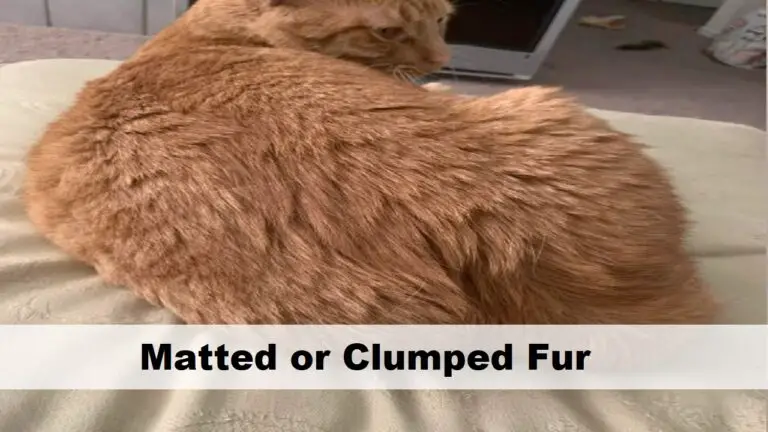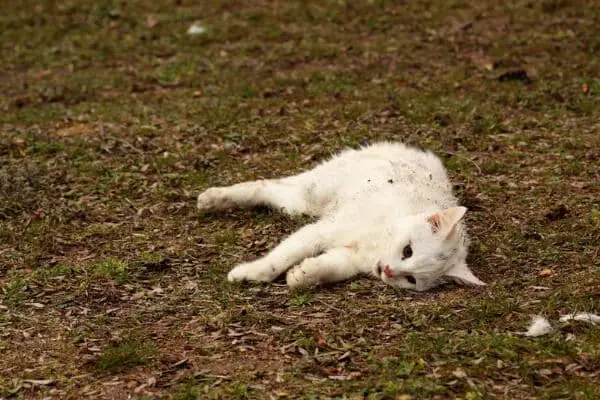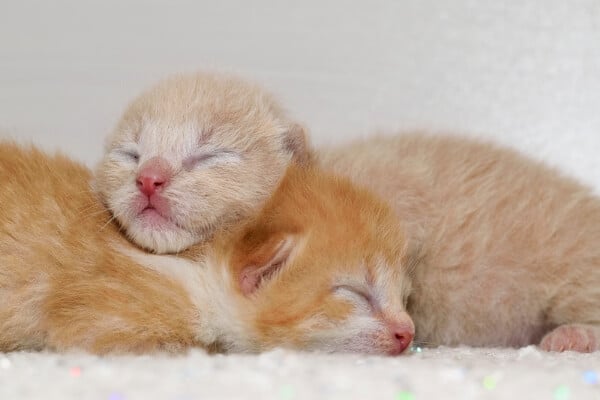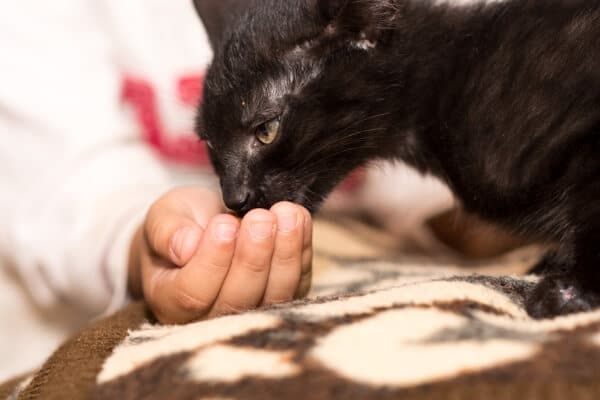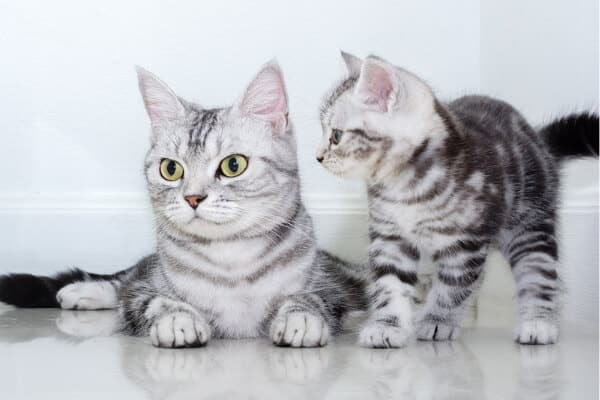Male Cat Trying To Mate With Kitten. Why And How To Stop It

When you live with felines, it’s not uncommon to witness some perplexing behaviors, highly frowned upon in the human world like a male cat trying to mount or mate with a kitten. So, why do cats behave in this way and how should you intervene as a cat parent?
Tom cats may try to mate or mount kittens as part of their sexual behavior influenced by certain hormones, a way to display dominance or just to play. Even though the kitten is too young for mating, the male cat’s instinctive mating drive doesn’t necessarily differentiate between potential partners based on age.
In other words, while feline mating can be driven by sexual stimulation, what is seen as an attempt to mate could be the male cat demonstrating his control within the social structure or just the male cat engaging the kitten in a rough-and-tumble game. It’s non-sexual if the tomcat is neutered or if the kitten is a male.
It’s important to monitor interactions between cats, especially when one is significantly older than the other. If the male cat’s actions become too assertive, creating a temporary separation can alleviate the kitten’s stress. Also, neutering your male cat can significantly decrease such tendencies, since it reduces the production of testosterone, which fuels dominant behavior.
Read Also: My Cat Got Pregnant By Her Son. Should I Be Worried?
Why Is My Male Cat Trying To Mate With The Kitten?
When a male cat appears to be trying to mate with a kitten, it can certainly raise eyebrows. Some of the reasons behind this puzzling conduct are listed below.
1: Sexual Behavior
The behavior of your male cat attempting to mate with the kitten can often be attributed to the influence of hormones. This is particularly true if the female kitten is experiencing her first heat cycle which typically occurs between 4 to 12 months. Testosterone, in particular, plays a pivotal role in governing the sexual behaviors of male cats. Being a powerful hormone, it induces strong sexual drives in male cats, compelling them to seek mates.
What’s intriguing is that this hormone doesn’t distinguish between potential mates based on their age or sexual maturity. Consequently, a male cat under the sway of his testosterone levels might end up displaying mating behavior towards a kitten who is not a suitable or ready mate.
2: Display Of Dominance
Cats, like many other animal species, have a social structure where displays of dominance are vital. Your male cat acting this way towards a kitten can also be a show of dominance, establishing his position in the social hierarchy. This behavior is not about the act of mating itself but about conveying a message of superiority to the other cats in the household.
This show of dominance isn’t confined to just mating-like actions. You might observe the male cat marking territory more frequently or pushing the kitten away from food or preferred resting spots. All of these actions contribute to the establishment of a hierarchy where the male cat secures a dominant role.
3: Playful Behavior
Cats, by nature, are playful creatures. They express a lot of their learning and socialization through the act of play. A male cat, while engaging in play with a kitten, might sometimes display behavior that resembles mating, which could include mounting the kitten or other physical actions associated with the mating process.
However, this isn’t genuine mating behavior, but rather a manifestation of the play dynamic between the two cats.
4: Misguided Instincts
Cats, like all animals, are driven by their instincts. These instincts are fundamental to their survival and behavior, guiding them in everything from hunting to mating. However, instincts can sometimes misfire, leading to behavior that seems odd or inappropriate to human observers.
A male cat, driven by his instinct to mate, might end up attempting to mate with a kitten, not recognizing the kitten’s age or lack of sexual maturity. While it might seem like the cat is making a conscious, albeit strange, choice, he’s just following his instincts.
How To Stop My Male Cat From Trying To Mate With Kitten
If you’re dealing with a male cat trying to mate with a kitten, it can indeed be a distressing scenario. Fortunately, there are several strategies you can adopt to navigate this situation and ensure the well-being of both cats. Here’s a guide to help you understand what to do:
1. Neuter The Tomcat
One of the most effective solutions to prevent inappropriate mating behavior in cats is neutering. Neutering a male cat involves a surgical procedure to remove the testicles, significantly reducing the levels of the hormone testosterone.
The reduction in testosterone generally leads to a decrease in aggressive and sexual behaviors, including attempts to mate with kittens. If your male cat hasn’t been neutered, it might be worth discussing the option with your vet.
2. Provide Separate Spaces
Creating separate spaces for the male cat and the kitten can be an effective temporary solution. Providing each cat with its own designated areas for sleeping, eating, and playing can help reduce tensions and unwanted behaviors. This can also give the kitten a sense of security, as it will have a safe space to retreat to if it feels threatened.
3. Socialize The Cats Properly
Proper socialization can also go a long way in mitigating inappropriate behaviors. Slow and careful introductions can help the cats get used to each other and establish a non-threatening relationship. Start with short, supervised interactions, gradually increasing the time they spend together as they become more comfortable with each other.
4. Use Behavior Modification Techniques
Behavior modification techniques can be useful in managing and changing your cat’s behavior. These techniques might include distraction, positive reinforcement, or gentle discouragement. For instance, if the male cat begins to exhibit inappropriate behavior towards the kitten, distract him with a toy or a game.
Similarly, rewarding the male cat when he interacts appropriately with the kitten can reinforce good behavior.
5. Consult A Professional
If your attempts to manage the situation don’t seem to be working, or if the behavior is causing significant stress to either cat, it might be time to consult a professional. A professional cat behaviorist or a vet will have the experience and knowledge to assess the situation and provide personalized advice based on your cats’ specific needs and behaviors.
Remember, each cat is unique, and what works for one might not work for another. Therefore, it’s important to monitor your cats’ reactions to these interventions and adjust your strategies as needed.
But My Male Cat Is Neutered. Why Is He Still Trying To Mate With Kitten And How Do I Stop Him?
Witnessing your neutered male cat still trying to mate with a kitten may be a surprise but it’s important to remember that such behavior is not always sexual. There could be several reasons for this:
Residual Hormones: Even after being neutered, a male cat can still have some residual hormones in their system. It can take several weeks or even a few months for all the hormones to fully leave the cat’s body. During this time, the cat might still exhibit mating behavior.
Learned Behavior: If the male cat was neutered later in life and had opportunities to mate before being neutered, the mating behavior could be a learned behavior. The cat may continue to exhibit this behavior due to past experiences.
Dominance Display: The behavior you’re interpreting as mating might be a show of dominance. Mounting behavior can be used by cats to establish hierarchy, and it’s not exclusive to male-female interactions.
Social Communication: Cats communicate in different ways, and this could be a part of their social interaction, regardless of whether they are neutered or not The behavior could be a method of expressing social dynamics or navigating their social environment.
To manage and curb this behavior, consider the following:
Distraction: Whenever you notice your cat starting to engage in this behavior, distract him with a toy, treat, or by initiating play. This strategy could help break the pattern over time. Make sure your cat has plenty of stimulating toys and activities to keep him busy. This enrichment can help reduce unwanted behavior by offering alternate forms of engagement.
Separation: The most straightforward way to separate the cats is by placing them in different rooms, especially if the female kitten is in heat. This is especially important when you are not present to supervise their interactions. Ensure both areas have everything they need, including food, water, litter boxes, and places to hide and rest.
Professional Consultation: If the behavior continues to be a problem, it might be beneficial to seek advice from a veterinary behaviorist. They can provide targeted strategies and interventions based on a comprehensive understanding of feline behavior.
At What Age Should You Stop Scruffing A Cat? When Is Too Old?
Male Cat Trying To Mate With Male Cat
While it might seem perplexing, instances of a male cat attempting to mate with another male cat aren’t uncommon in the realm of feline behavior. Such actions can be influenced by a combination of instinctual, hormonal, and environmental factors, illustrating the complex social dynamics of our feline friends.
This behavior, commonly perceived as mating, can be an expression of dominance or territorial assertion. In feline social structures, mounting can be a method of establishing or reinforcing hierarchy. It’s not exclusive to male-male interactions but can also occur between cats of opposite sexes or between females. These actions aren’t driven by sexual motivation, but rather by a need to communicate social standing within their environment.
From a physiological standpoint, hormonal influences can also trigger this behavior. If one or both cats involved are not neutered, the presence of male hormones can stimulate mating-like actions. Even if the recipient cat is male, the assertive cat may respond to scents and signals that trigger a hormonal reaction. In cases where a cat has been recently neutered, the residual hormones in his system may elicit similar behavior, which often decreases over time post-surgery.
While these actions may appear concerning to us, they may be part of normal communication between cats. Dealing with this behavior necessitates an understanding of the underlying cause. If it’s a display of dominance, providing each cat with its own space and resources (food, litter boxes, etc.) can help reduce competition and conflict, which might mitigate this behavior, and in multi-cat households, consider separating cats temporarily.
Nevertheless, if such behavior becomes overly aggressive, causes distress, or alters the harmony of your household, it’s advised to consult a professional, such as a vet or animal behaviorist. They can offer guidance and potential solutions tailored to your specific situation, ensuring a balanced and peaceful cohabitation between your pets.
Final Thoughts
A male cat attempting to mate with a kitten is an issue that underscores the need for timely intervention. Such behavior, if not mitigated, can lead to health risks and overpopulation, making the role of pet owners crucial. This situation necessitates a safe and monitored environment for all cats, particularly those that are most vulnerable.
Thus, understanding feline behaviors and mating patterns is more than an academic endeavor. It’s a commitment to creating an environment where cats can thrive in health and happiness. This duty should be a paramount concern for all cat owners.
The responsibility rests on us, the human caregivers, to create an environment where cats can thrive and grow without facing unnecessary stresses or risks. This includes adopting measures like spaying and neutering, and keeping kittens safe from adult males until they reach an appropriate age for mating. It’s about conscious care that prioritizes their well-being above all else.
Read related posts about

